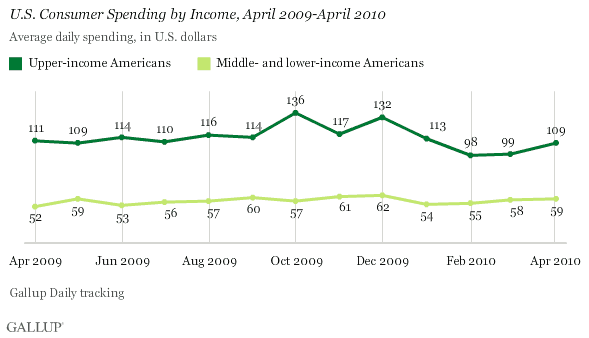PRINCETON, NJ -- Americans' self-reported spending rose to $66 per day in April -- up 10% year over year. The impetus behind the increase was a 13% rise in middle- and lower-income spending, to $59 per day. Although high gas prices and last year's weak recession-based comparables probably played a key role in April's spending increase, the improving jobs situation likely also contributed.

Not all Americans contributed to the April year-over-year increase. Upper-income spending was essentially unchanged at $109 per day. Still, even this weak number represents an improvement over the record-low upper-income spending of February and March 2010.
Year-Over-Year Gains in All Regions but the East
Spending was highest in the West, at $72 per day, and lowest in the East, at $56. Spending increased 18% in the West, 14% in the Midwest, and 10% in the South compared to a year ago. Year-over-year spending was essentially unchanged in the East.

Upper-Income Spending Pattern Supports New Normal
The year-over-year increase in self-reported spending seen this April is good news, particularly given that this year, most of the week before Easter -- which usually brings a spike in spending -- was in March. The 5% increase in April spending compared to that of March is also welcome news. Gallup's modeling suggests that job increases lead to increased spending -- especially among middle- and lower-income consumers.
More importantly, the finding that upper-income Americans are still not spending more than they were a year ago suggests that the 2009 spending "new normal" continues to dominate. These consumers, who have disposable income, are choosing to spend at the lower part of the new normal range ($107 to $121) they established during 10 of 12 months in 2009.
If these upper-income spending trends persist, they suggest a slower-than-average U.S. economic recovery during the second half of 2010.
Review and export the complete daily trends on these measures: Economic Indexes; Consumer Spending; Economic Outlook; Economic Conditions; Job Market; U.S. WorkforceLearn more about Gallup's economic measures.
For Gallup Daily tracking, Gallup interviews approximately 1,000 national adults, aged 18 and older, each day. The Gallup consumer spending results are based on random half-samples of approximately 500 national adults, aged 18 and older, each day. Results for April are based on telephone interviews with more than 14,000 adults. For these results, one can say with 95% confidence that the maximum margin of sampling error is ±1 percentage point. Results for the various breakouts reported here are based on interviews with more than 2,000 respondents, with a maximum margin of error of ±3 percentage points.
Interviews are conducted with respondents on landline telephones and cellular phones.
In addition to sampling error, question wording and practical difficulties in conducting surveys can introduce error or bias into the findings of public opinion polls.
